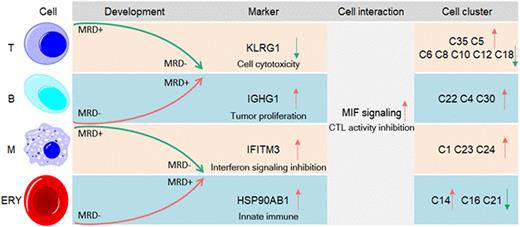Abstract
Measurable residual disease (MRD) is the most important prognostic marker for relapse after allogeneic hematopoietic stem cell transplantation (allo-HSCT) in acute myeloid leukemia (AML). Unfortunately, our understanding of critical immune cell clusters in bone marrow (BM) which contribute to MRD occurrence is limited. Thus, we generated 184,231 single-cell transcriptomes to compare the BM immune cell landscape between MRD positive and negative patients. KLRG1-CD8+ T cell and KLRG1+CD8+ T cell clusters were prevalent in MRD positive and negative patients, respectively, demonstrating significantly different gene expression profiles (particularly cytotoxicity genes). KLRG1+CD8+ T cells showed a stronger cytotoxicity to leukemia cells compared with KLRG1-CD8+ T cells in vitro. Exhausted CD8+ T cell clusters were similar between MRD positive and negative patients. In addition, IGHG1+ B cells, IFITM3+ monocytes, and HSP90AB1+ erythrocytes were associated with MRD occurrence. MRD clearance by immunotherapies was accompanied with the increase of KLRG1+CD8+ T cell clusters and decrease of KLRG1-CD8+ T cell, IGHG1+ B cell, IFITM3+ monocyte, and HSP90AB1+ erythrocyte clusters, and vice versa. An independent cohort showed that the decrease of immune cell clusters which were prevalent in MRD positive patients was associated with MRD achieving negative after allo-HSCT. Macrophage migration inhibitory factor pathway might be the critical pathway among these immune cell populations, and it was weakened in MRD patients who showed response to immunotherapy. We firstly provided a complete landscape on BM immune cells in MRD stage which will facilitate a better understanding of the immune mechanisms for MRD occurrence in AML.
Disclosures
No relevant conflicts of interest to declare.
Author notes
Asterisk with author names denotes non-ASH members.


This feature is available to Subscribers Only
Sign In or Create an Account Close Modal